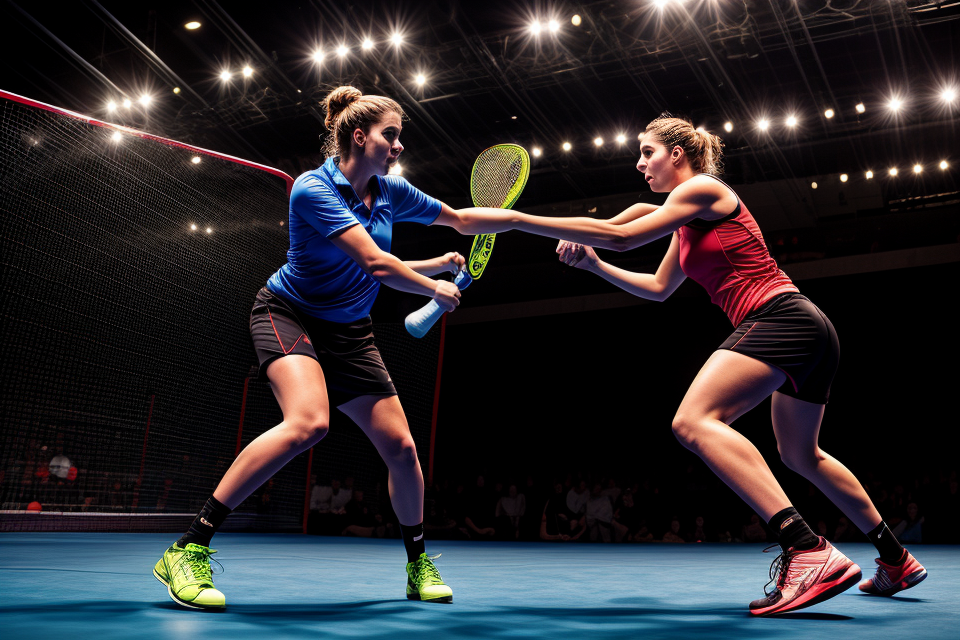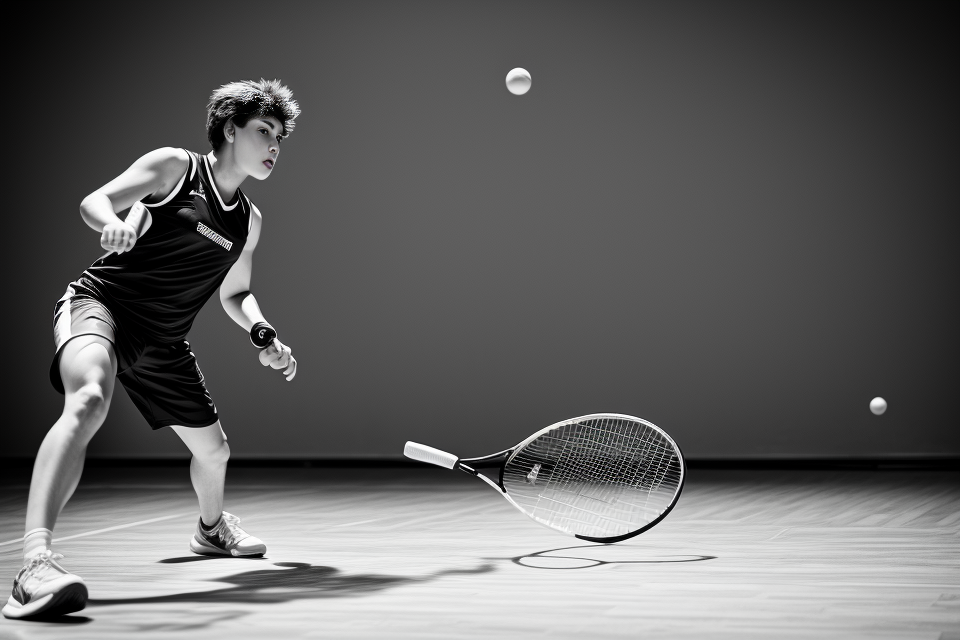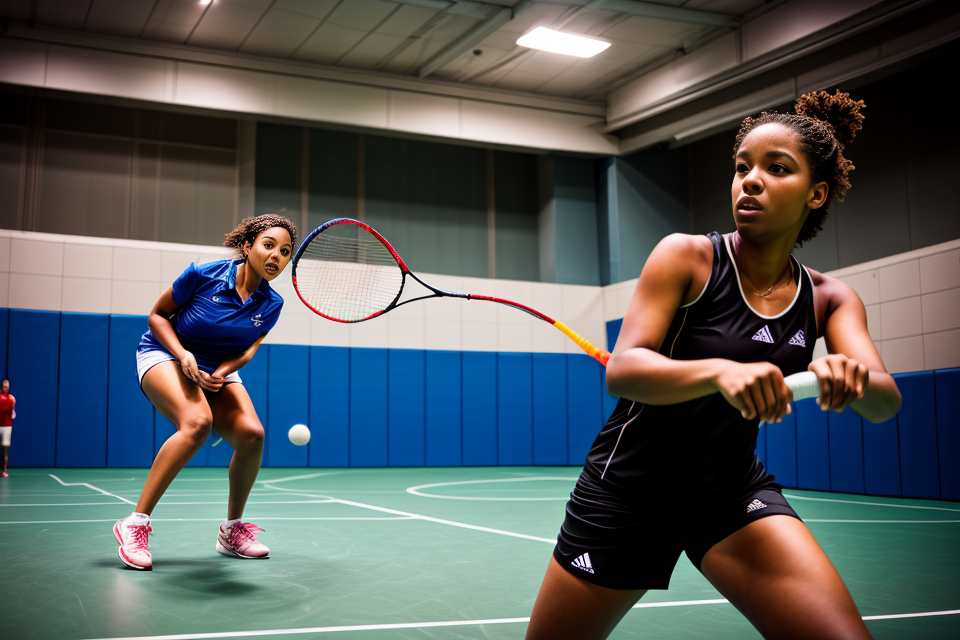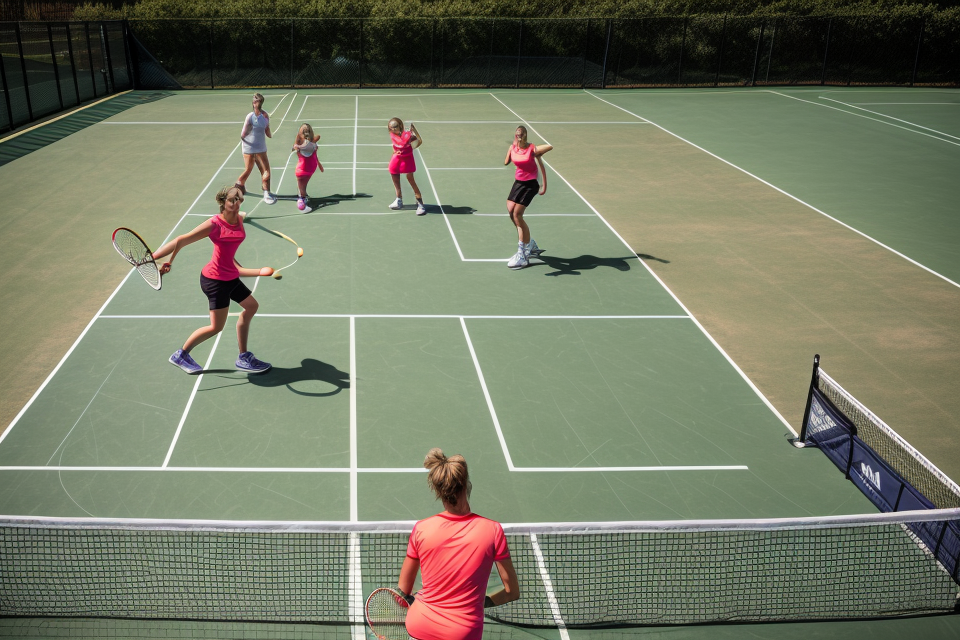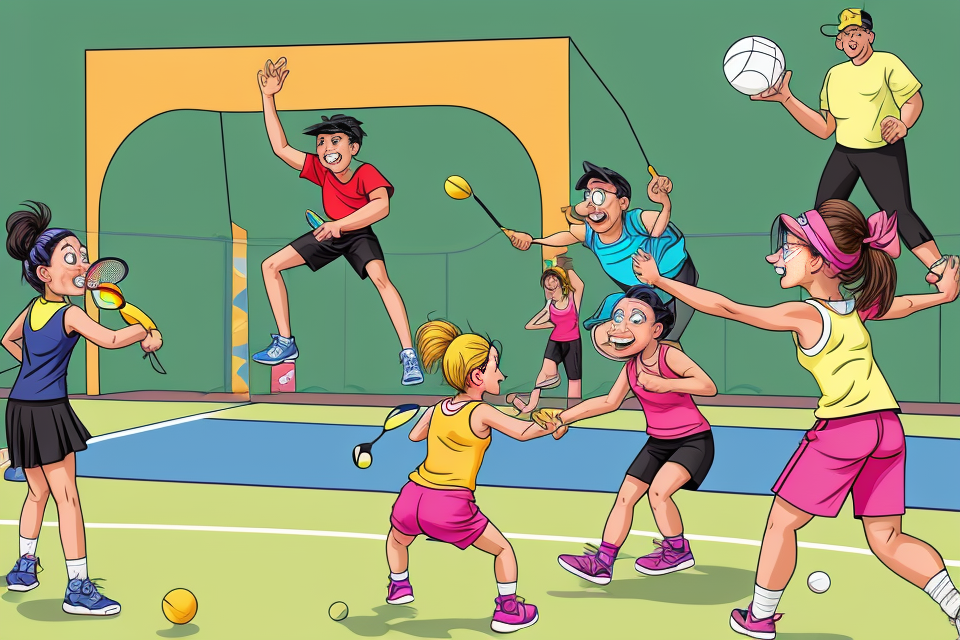Squash is a sport that requires immense physical and mental strength. It is often regarded as one of the most challenging sports due to its fast-paced and demanding nature. Whether you are a beginner or an experienced player, squash can be a daunting sport to take up. However, with the right guidance and practice, anyone can master the game. In this comprehensive guide, we will explore the challenges of squash and why it is considered one of the hardest sports. We will also provide tips and tricks for beginners to help them get started on their squash journey. So, are you ready to take on the challenge? Let’s dive in!
Understanding the Physical Demands of Squash
Fitness Requirements for Squash
Squash is a physically demanding sport that requires a range of fitness attributes to perform at a high level. The following are the key fitness requirements for squash:
Aerobic Fitness
Aerobic fitness refers to the ability of the body to efficiently deliver oxygen and nutrients to the muscles during sustained physical activity. Squash is an anaerobic sport, meaning that energy is produced without the use of oxygen. However, a high level of aerobic fitness is still important as it helps to improve endurance and reduce the risk of injury. Aerobic fitness can be improved through activities such as running, cycling, and swimming.
Anaerobic Fitness
Anaerobic fitness refers to the ability of the body to produce energy without the use of oxygen. Squash is primarily an anaerobic sport, meaning that energy is produced through the breakdown of glucose without the involvement of oxygen. To perform at a high level in squash, players need to have a high level of anaerobic fitness, which can be improved through activities such as interval training, plyometrics, and weightlifting.
Strength and Power
Squash requires players to have a high level of strength and power in their legs, core, and upper body. Leg strength is important for hitting powerful shots and moving around the court, while core strength helps to improve balance and stability. Upper body strength is important for hitting accurate shots and maintaining proper technique. Strength and power can be improved through activities such as weightlifting, resistance training, and plyometrics.
Flexibility and Mobility
Flexibility and mobility are also important for squash players. Good flexibility and mobility help to improve range of motion, reduce the risk of injury, and allow players to perform at a high level. Flexibility can be improved through activities such as stretching and yoga, while mobility can be improved through activities such as dynamic warm-ups and mobility exercises.
Skillset Required in Squash
Footwork
In squash, footwork is crucial to the success of a player. It involves moving swiftly and strategically around the court, which requires excellent agility, balance, and coordination. Players must be able to change direction quickly, accelerate, and decelerate with precision. They must also have the ability to move efficiently in any direction, including sideways, backward, and forward. Good footwork in squash involves mastering various movements such as running, stopping, pivoting, and positioning oneself for a shot.
Eye-hand Coordination
Eye-hand coordination is a critical skill in squash. Players need to be able to track the ball’s movement accurately and hit it with precision. This requires excellent hand-eye coordination, which can be developed through practice and repetition. Players must also have the ability to adjust their swing speed and direction based on the speed and trajectory of the ball. Good eye-hand coordination is essential for hitting accurate shots, such as volleys, drops, and drives.
Agility and Reflexes
Squash is a fast-paced sport that requires excellent agility and reflexes. Players must be able to move quickly and react to their opponent’s movements, anticipating their shots and positioning themselves for a return. Agility and reflexes are crucial for hitting sharp angles and retrieving difficult shots. Players must also be able to move quickly to the front of the court to hit shots that require them to be close to the wall.
Mental Focus and Strategy
Mental focus and strategy are also crucial in squash. Players must be able to concentrate on the game and stay focused throughout the match. This requires mental toughness, resilience, and the ability to handle pressure. Players must also have a good understanding of the game’s strategy, including the use of tactics such as boasting, lobbing, and drop shots. Good mental focus and strategy can help players make informed decisions on the court and outsmart their opponents.
The Role of Equipment in Squash
- Racket selection
- A racket is an essential piece of equipment in squash, as it is used to hit the ball during the game.
- There are different types of rackets available, each with its own unique characteristics.
- Factors to consider when selecting a racket include the weight, balance, and string tension.
- It is recommended to try out different rackets before making a purchase to ensure the best fit for the player’s style and preferences.
- String tension and grip
- String tension refers to the amount of force applied to the strings when they are strung together.
- A higher tension can result in more power and control, while a lower tension can produce more spin and control.
- The grip is the area where the player holds the racket, and it is important to choose a grip that is comfortable and provides a secure hold.
- A thicker grip may be more suitable for players with a firmer grip, while a thinner grip may be better for players with a looser grip.
- Court shoes
- Court shoes are designed specifically for squash and provide the necessary support and traction needed on the court.
- They typically have a non-marking sole to prevent scuff marks on the court and a durable outer sole for traction.
- It is important to choose a shoe that fits well and provides the necessary support and cushioning for the player’s foot.
- Protective gear
- Squash can be a physically demanding sport, and protective gear is recommended to prevent injury.
- Eye protection is particularly important, as squash balls can travel at high speeds and may cause injury to the eyes.
- Other protective gear includes wrist guards, knee pads, and elbow pads.
- It is important to choose protective gear that fits well and provides the necessary support and protection for the player.
Comparing Squash to Other Sports
Cardiovascular Intensity of Squash
- Comparison with other racquet sports
- Tennis: Although both squash and tennis are racquet sports, the intensity of squash is higher. Squash is a high-intensity, anaerobic sport that requires quick movements and explosive power, while tennis is more aerobic and allows for longer rallies.
- Badminton: While badminton is also a racquet sport, it is not as physically demanding as squash. Squash requires more jumping, lunging, and quick changes of direction, making it a more intense workout.
- Comparison with non-racquet sports
- Basketball: While both squash and basketball require running and jumping, squash is more physically demanding due to the constant stopping and starting, rapid direction changes, and high intensity.
- Soccer: While soccer requires endurance and running, it is not as physically demanding as squash due to the longer breaks between intense bursts of activity. Squash is a sport that requires constant movement and exertion.
In conclusion, squash is a sport that is high in cardiovascular intensity compared to other racquet sports and non-racquet sports. It requires quick movements, explosive power, and constant exertion, making it a challenging sport for players of all levels.
Physicality of Squash
Squash is a physically demanding sport that requires a high level of fitness and endurance. To better understand the physicality of squash, it is helpful to compare it to other racquet sports and non-racquet sports.
Comparison with other racquet sports
Compared to other racquet sports such as tennis and badminton, squash is considered to be the most physically demanding. This is due to the smaller court size and the fast-paced nature of the game. In squash, players are constantly moving and changing direction, which requires quick footwork and agility. Additionally, the ball is hit with greater force and velocity in squash compared to other racquet sports, which increases the demands on the player’s physical fitness.
Comparison with non-racquet sports
When compared to non-racquet sports, squash can be considered a high-intensity sport. The physical demands of squash are similar to those of sports such as soccer, basketball, and rugby. These sports also require players to have a high level of endurance, strength, and agility. However, squash has the added element of the overhead serve, which requires explosiveness and coordination.
Overall, the physicality of squash makes it a challenging sport for players of all levels. To excel in squash, players must have a combination of strength, endurance, agility, and coordination. Additionally, players must be able to withstand the physical demands of the game, including rapid changes in direction, jumps, and lunges.
Mental Demands of Squash
Squash is a sport that demands a high level of mental toughness and concentration from its players. This is evident when comparing it to other racquet sports such as tennis and badminton. In these sports, players have more time to react to their opponent’s shots and can use strategies such as changing the pace of the ball or hitting it to the side of the court to gain an advantage. In contrast, squash is a fast-paced sport with very little time between points, which means that players must be constantly alert and ready to respond to their opponent’s shots.
Squash also demands a high level of mental toughness when compared to non-racquet sports such as soccer or basketball. In these sports, players have the luxury of running up and down the field or court, which allows them to rest between plays. In squash, players are constantly moving and must be in top physical condition to keep up with the fast pace of the game. This means that players must not only be physically fit but also mentally tough and able to handle the intense physical demands of the sport.
Additionally, squash requires players to be able to think quickly and make split-second decisions on the court. This is especially true for beginners who are still learning the game and must adjust to the fast pace of play. Players must be able to think ahead and anticipate their opponent’s moves, while also being able to adapt to changing circumstances on the court. This requires a high level of mental focus and concentration, which can be challenging for beginners who are still learning the game.
Overall, squash is a sport that demands a high level of mental toughness and concentration from its players. Whether compared to other racquet sports or non-racquet sports, squash stands out as a sport that requires players to be constantly alert and ready to respond to their opponent’s shots, while also being able to think quickly and make split-second decisions on the court.
The Learning Curve of Squash
Techniques for Beginners
As a beginner in squash, it is important to learn the proper techniques to develop good fundamentals and build a strong foundation for your game. Here are some of the key techniques that you should focus on as a beginner:
Grip and Stance
The grip and stance are crucial elements of the squash game. A proper grip on the squash racquet allows you to control the ball effectively and generate power. A good stance provides stability and balance, which is essential for executing shots accurately.
To develop a good grip, hold the racquet with your dominant hand at the top of the handle and your non-dominant hand at the bottom. Your dominant hand should be responsible for controlling the direction of the shot, while your non-dominant hand provides support and stability.
In terms of stance, stand with your feet shoulder-width apart and slightly bent knees. Keep your weight balanced evenly on both feet, with your front foot pointing slightly towards the direction of the ball. Your arms should be relaxed and extended in front of your body, with the racquet ready to strike the ball.
Basic Shots
The basic shots in squash include the serve, forehand, and backhand. As a beginner, it is important to master these shots to build a solid foundation for your game.
The serve is the first shot in the game and is used to start the point. To serve, stand behind the right-hand service line and throw the ball straight up in the air. When the ball reaches its highest point, hit it with your racquet in a downward motion towards the front wall.
The forehand shot is one of the most important shots in squash. To execute a forehand shot, stand with your front foot pointing towards the direction of the ball. Hold the racquet with your dominant hand at the top of the handle and your non-dominant hand at the bottom. Swing the racquet in a forward motion, hitting the ball with the face of the racquet towards the front wall.
The backhand shot is similar to the forehand shot, but executed with your non-dominant hand. Stand with your front foot pointing towards the direction of the ball, and swing the racquet in a forward motion, hitting the ball with the face of the racquet towards the front wall.
Footwork Drills
Footwork is an essential aspect of squash, as it allows you to move around the court and position yourself for shots. As a beginner, it is important to practice footwork drills to develop good movement and agility on the court.
Some footwork drills to try include:
- Forward and backward running: Run back and forth across the court, focusing on maintaining a steady pace and good form.
- Square step drill: Move diagonally across the court, taking square steps with each movement. This drill helps develop quick footwork and the ability to change direction quickly.
- Shuffle drill: Shuffle sideways across the court, focusing on keeping your feet moving and your weight balanced. This drill helps develop agility and the ability to move quickly from side to side.
By focusing on these techniques as a beginner, you can develop a strong foundation for your squash game and set yourself up for success on the court.
Progression of Skills
As with any sport, mastering the basics of squash is crucial before advancing to more complex techniques. Here is a breakdown of the progression of skills needed to become proficient in squash:
- Basic strokes:
- Forehand drive
- Backhand drive
- Volley
- Serve
- Advanced techniques:
- Drop shot
- Lob
- Boast
- Nick
- Counter-drive
- Matchplay strategies:
- Positioning and footwork
- Tactics and court coverage
- Mental preparation and focus
- Physical and mental conditioning:
- Fitness training
- Agility and reaction time
- Endurance and stamina
- Mental toughness and resilience
Note that the progression of skills may vary depending on individual learning styles and pace. It is important to have a solid foundation in the basics before attempting more advanced techniques. With consistent practice and dedication, squash can be a challenging yet rewarding sport for players of all levels.
Common Mistakes to Avoid
Squash is a sport that requires a great deal of technical skill and physical fitness. As a beginner, it can be easy to make mistakes that can hinder your progress and make the game more challenging than it needs to be. Here are some common mistakes to avoid when learning to play squash:
- Grip and stroke errors: One of the most common mistakes beginners make is using the wrong grip on the squash racket. A correct grip is essential for producing powerful shots and maintaining control over the ball. Additionally, a poor stroke can lead to shots that go out of bounds or are too soft, making it difficult to keep the rally going.
- Footwork mistakes: Good footwork is crucial in squash, as it allows players to move around the court quickly and effectively. Common footwork mistakes include not moving forward enough when hitting the ball, not moving backward quickly enough when returning a shot, and not being in the right position to hit the ball.
- Lack of court awareness: Squash is a game that requires players to be aware of their surroundings at all times. This includes knowing where the walls are, where the ball is likely to bounce, and where your opponent is positioned on the court. Players who lack court awareness may find themselves in awkward positions or getting hit by the ball unexpectedly, which can lead to errors and losses.
By avoiding these common mistakes, beginners can set themselves up for success on the squash court and begin to develop the skills necessary to become proficient players.
Final Thoughts
Squash is often considered one of the most challenging sports due to its fast-paced and physically demanding nature. For beginners, mastering the game can be a daunting task, but with dedication and practice, it is possible to improve skills and become proficient in the sport.
One of the main reasons why squash is challenging is because it requires a high level of fitness. The game involves a lot of running, jumping, and sudden changes in direction, which can be demanding on the body. In addition, the small court size means that players are always on the move, making it difficult to catch a break.
Another factor that contributes to the difficulty of squash is the strategic aspect of the game. Unlike other sports, squash is a one-on-one game, which means that players must constantly think about their opponent’s movements and plan their own strategy accordingly. This requires a high level of mental agility and quick thinking, which can be challenging for beginners.
However, despite the challenges, squash is also a rewarding sport that can offer many benefits to those who persevere. For beginners, it is important to start with the basics, such as learning how to hit the ball correctly and understanding the rules of the game. Practice is also key, as it allows players to develop their skills and build confidence on the court.
In addition, seeking guidance from a coach or experienced player can be helpful for beginners. A coach can provide feedback on technique and offer tips on how to improve, while an experienced player can provide insight into the strategic aspects of the game.
Overall, while squash may be considered one of the most challenging sports, it is also a rewarding and exciting game that can offer many benefits to those who are willing to put in the time and effort to improve their skills. With dedication and practice, anyone can become proficient in the sport and enjoy the many benefits it has to offer.
FAQs
1. What is squash?
Squash is a racquet sport played by two players in a four-walled court. The objective of the game is to hit the ball in such a way that your opponent is unable to return it. It is a high-intensity sport that requires strength, endurance, and mental toughness.
2. Is squash one of the hardest sports?
Squash is often considered one of the most challenging sports due to its fast-paced and physically demanding nature. It requires a high level of fitness, technical skill, and mental fortitude to be successful. It is also a technical sport that requires precision and accuracy to hit the ball in the right spot and at the right speed.
3. What skills are required to play squash?
To play squash, you need to have good hand-eye coordination, footwork, and endurance. You also need to have good technique, including the ability to hit the ball with precision and power, as well as the ability to move around the court quickly and efficiently. Additionally, mental toughness and the ability to think on your feet are crucial in squash, as the game can change quickly and unexpectedly.
4. What are the benefits of playing squash?
Playing squash has many benefits, including improved cardiovascular fitness, increased flexibility and mobility, and improved hand-eye coordination. It is also a great way to relieve stress and improve mental focus and concentration. Additionally, squash is a social sport that can be played with friends or opponents of all skill levels, making it a great way to meet new people and make connections.
5. What equipment do I need to play squash?
To play squash, you need a squash racquet and a squash ball. The racquet should be comfortable and suitable for your playing style, and the ball should be in good condition and meet the standards set by the World Squash Federation. Additionally, you should wear appropriate athletic clothing and shoes that provide good support and traction on the court.
6. How can I improve my squash skills?
To improve your squash skills, you should focus on developing your technical abilities, such as your stroke mechanics and footwork. You should also work on your physical fitness and endurance, as well as your mental toughness and strategic thinking. Practicing regularly and playing against opponents of different skill levels can also help you improve your game. Additionally, seeking the guidance of a professional coach or joining a squash club can provide valuable feedback and support as you progress.






